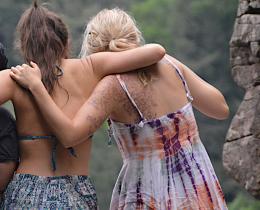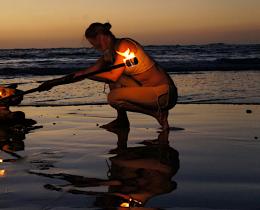Omega: You have described how people can respond to trauma by being anxious and hypervigilant (stuck “on”), or by being dissociated and spacy (stuck “off"). How do you lead a class that accommodates both of these reactions to trauma?
Hala: Some people might walk into class and connect with their body sensations and feel good right away. For others, connecting to their sensations could be really overwhelming. We want to make sure to name that, to acknowledge that someone might only be aware of pain and not be feeling good. We could say, “You might only be aware of how much pain you’re in right now. Can you take a breath and feel that pain? Can you feel your feet on the ground as you feel that pain?” We want to make sure we’re teaching in a way that captures both experiences and everyone in between.
One of my mentors says, "Anybody who claims there's one way to work with trauma doesn't know how to work with trauma." In so many ways it's really specific to what that person needs, but the general principles when we're teaching the group are trying to bring compassion to wherever that person is, to normalize the idea that being with our sensations can be scary, and to guide the mind to look for anything that might be feeling safe or resourced in the body, because with trauma the mind is usually looking for what feels bad, and not trusting that we can feel good.
Omega: Can you suggest something a yoga teacher can incorporate into their next class to be more trauma-sensitive?
Hala: The first thing I would say is to assume everything your students are doing is their attempt to self-regulate. Whether they can't shut their phone off, or they're looking around and can’t settle, in your own body can you have compassion instead of judgment? Can you have an attitude of giving people the benefit of the doubt?
The second thing is to use your queuing to teach your students to connect to their sensations in a compassionate way. So instead of encouraging them to get a pose right, instead say, "Notice where you feel that in your body. If it’s uncomfortable, can you be compassionate toward that? Can you breathe as you feel the discomfort?” We're not trying to have our students not be uncomfortable; we're trying to have them be able to tolerate being uncomfortable.
Omega: Are there things you might want to avoid saying as a teacher?
Hala: I don't like telling people to relax, especially when you just put them in something uncomfortable. With sexual trauma that's often what the perpetrator said. Telling them to relax is kind of obnoxious in that case. Relax suggests that they deny that something is uncomfortable. Instead you might say, “Notice that your shoulders are riding up by your ears. Can you take a breath into that?" You’re letting them know it’s okay to be uncomfortable, and then they may notice that things get a little bit better once they do that.
Omega: What can a teacher do to avoid burnout, distress, or overwhelm and maintain hope when working with those affected by trauma?
Hala: First you have to do your own personal work. Have a grasp on your own trauma, because your traumas will get triggered. If you haven't tended to that, if you’re not getting support on that, that can immediately burn you out.
I love the term "trauma stewardship." It’s the title of a book by Laura van Dernoot Lipsky, who works with direct service providers on compassion fatigue, vicarious trauma, and self-care. She says that what helps heal trauma is the quality of our presence in the face of other peoples' trauma, as well as the hope and faith that we can be transformed by our traumas and that our traumas can be transformed into healing and hope.
We can't go in thinking we're there to heal everybody's trauma and take their pain away. That's going to be exhausting. Rather, we are there to bear witness in a compassionate way, and hold space for them as they move through their pain so they can discover their own resilience. Those are two really different attitudes. One is more of a codependent "I need to fix you because this is intolerable to me," and the second is "I have faith because I've also done this with myself."
Omega: What encouragement can you give teachers who may feel ill-equipped to handle reactions from a student whose trauma is triggered in class?
Hala: The first thing is to get yourself regulated. Make sure you're breathing; make sure you're grounded. The best thing we can do is stay calm in the face of whatever overwhelm our student might be going through. Once you’re grounded you might offer a normalizing response like, "It looks like you're overwhelmed." Maybe say to that person, "Can you take a breath?" or "Can you look around the room?"
It’s also important to have a list of people you can refer a student to. Make sure you know your scope of practice, and if it looks like somebody's overwhelmed, or dissociating, or having a panic attack, in the moment keep yourself as calm as possible, and get that person to safety. Whether it means calling an ambulance, calling their emergency contact, or just sitting with them until they settle, and then making sure that they get some good therapy.
Omega: Is there any room for levity when working with trauma?
Hala: I once did a 3-day trauma training with a group of social workers, direct service providers, and survivors of trauma. There was a deep understanding of trauma in the room, and you would have thought it was a comedy workshop. We were laughing the whole time, and what was so amazing was, because it was this particular group, the laughter wasn't an attempt to bypass the discomfort, but because they knew that if you’re going to do this work you have to have a sense of humor.
The more I do trauma work, the more I do social justice work, the more I see the need for laughter, creativity, joy, and play. Prior to really being steeped in this work, I always thought of fun as an indulgence—now I see it as an absolute necessity. I even have a section of comedy links on my website.
Omega: Do you advertise your classes as trauma-informed?
Hala: Not necessarily. I teach public yoga classes at a yoga studio that are just called mixed level. It’s just that I’m teaching yoga in a way that recognizes how human beings operate. Even though there’s diversity in our life experiences, trauma impacts us all similarly. I’ve taught yoga to many different kinds of people—including incarcerated people, social workers, moms—and I get similar feedback.
The first time I taught incarcerated girls and veterans I was really nervous, but people come up to me after and say, “I felt like you were speaking for me.” There’s something universal about this trauma-informed perspective that goes beyond age, race, or life experiences.



